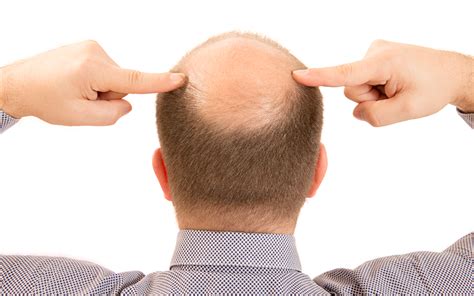Unlock the Truth Behind the Myth

For centuries, the debate has raged on: can shaving your hair help combat balding? While the answer may not be a simple yes or no, scientific evidence sheds light on the complex relationship between hair growth and shaving.
What Causes Balding?
Balding, medically known as alopecia, is a common condition affecting both men and women. It occurs when hair follicles become miniaturized, leading to a gradual thinning and loss of hair. The primary cause of balding is genetics, specifically the presence of a gene called the androgen receptor (AR).
When the AR interacts with the hormone dihydrotestosterone (DHT), it triggers a process that causes hair follicles to shrink. This shrinking eventually leads to reduced hair production and, ultimately, balding.
Shaving and Hair Growth
The misconception that shaving hair can fight balding stems from two common observations:
1. Temporary Thickening: Shaving hair can create the illusion of thicker hair by removing tapered ends. However, this effect is purely cosmetic and does not stimulate new hair growth.
2. Increased Blood Flow: The act of shaving can increase blood flow to the scalp. While increased blood flow may nourish hair follicles, it has not been scientifically proven to prevent or reverse balding.
Scientific Evidence
Multiple studies have investigated the relationship between shaving and hair growth.
- The British Journal of Dermatology (2012): Researchers found no evidence that shaving promotes hair growth.
- The International Journal of Trichology (2014): A comprehensive review of the literature concluded that there is no scientific basis for the claim that shaving prevents balding.
- The Journal of Cosmetic Dermatology (2017): A study of 100 men with male pattern baldness showed no significant difference in hair growth between those who shaved and those who did not.
Other Factors That Affect Balding
While genetics play a dominant role in balding, other factors can also contribute:
- Age: Hair follicles become more susceptible to thinning with age.
- Hormonal Changes: Fluctuations in hormone levels, such as those experienced during puberty or menopause, can affect hair growth.
- Certain Medications: Some medications, such as chemotherapy drugs, can cause temporary or permanent hair loss.
- Medical Conditions: Underlying medical conditions, such as thyroid disorders or lupus, can lead to hair thinning.
- Lifestyle Factors: Stress, poor nutrition, and smoking can all take a toll on hair health.
Conclusion
The evidence overwhelmingly suggests that shaving your hair does not prevent or reverse balding. This widespread myth is likely perpetuated by anecdotal accounts and wishful thinking.
However, maintaining a healthy lifestyle, managing stress, and seeking professional advice from a dermatologist can all help support hair health and minimize the impact of balding.
1. Can shaving make hair grow faster?
No, shaving does not stimulate new hair growth. It only removes the tapered ends of hair, creating the illusion of thicker hair.
2. Can shaving prevent balding?
No, scientific evidence shows that shaving has no effect on preventing balding.
3. Can shaving cause hair to grow darker?
Shaving does not affect the color of hair. The dark color of freshly shaved hair is due to the blunter ends.
4. Can shaving cause hair loss?
No, shaving does not cause hair loss. However, it can make hair appear thinner by removing the tapered ends.
5. Can hair loss be reversed?
In some cases, hair loss can be reversed if it is caused by underlying medical conditions or certain medications. However, genetic hair loss is typically permanent.
6. What treatments are available for balding?
Common treatments for balding include minoxidil, finasteride, laser therapy, and hair transplantation.
| Myth | Fact |
|---|---|
| Shaving can prevent balding | Shaving has no effect on preventing balding |
| Shaving makes hair grow faster | Shaving only removes tapered hair ends |
| Shaving causes hair to grow darker | Shaving does not affect hair color |
| Shaving can cause hair loss | Shaving does not cause hair loss |
| Cause | Explanation |
|---|---|
| Genetics: | Primary cause of balding, particularly the presence of the androgen receptor (AR) gene |
| Age: | Hair follicles become more susceptible to thinning with age |
| Hormonal Changes: | Fluctuations in hormone levels can affect hair growth |
| Certain Medications: | Medications such as chemotherapy drugs can cause temporary or permanent hair loss |
| Medical Conditions: | Underlying medical conditions, such as thyroid disorders or lupus, can lead to hair thinning |
| Factor | Impact on Hair Health |
|---|---|
| Stress: | Can lead to hair shedding (telogen effluvium) |
| Poor Nutrition: | Deficiencies in essential vitamins and minerals can weaken hair |
| Smoking: | Damages hair follicles and restricts blood flow to the scalp |
| Treatment | Mechanism of Action |
|---|---|
| Minoxidil (Rogaine): | Stimulates hair growth and prevents hair loss |
| Finasteride (Propecia): | Blocks the production of DHT, the hormone that triggers hair thinning |
| Laser Therapy: | Low-level laser energy stimulates hair follicles and promotes hair growth |
| Hair Transplantation: | Surgical procedure to transfer healthy hair follicles to balding areas |
